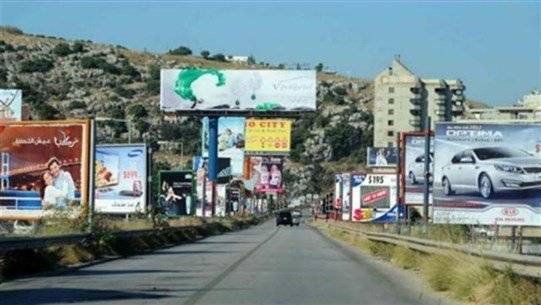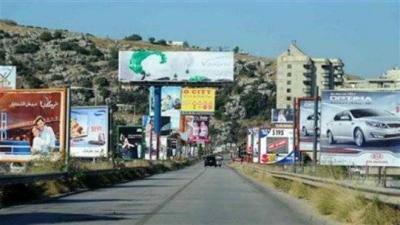A few days ago, Minister of Public Works and Transport Ali Hamieh issued a circular for the removal of all advertising billboards placed on public properties belonging to the ministry in violation of regulations and for the reorganization of the licensing process. The circular is an attempt to control the rampant chaos in this sector, but it is not the first. Over two decades, all attempts have failed, especially since the influence of companies and their connections with the "deep state" and municipalities are extensive and strong, placing the minister's circular in front of a serious challenge.
The circular stated that "the ministry has found that all advertisements placed on the properties belonging to the Ministry of Public Works and Transport violate the provisions of Decree 1302/2015 (which regulates the advertising sector)." It emphasized that "owners of billboards that do not have the approval of the Ministry of Public Works and Transport and are not licensed by the municipality must immediately remove them at their own expense and responsibility." As for the billboards licensed by the municipality but lacking the approval of the Ministry of Public Works, their owners are given "a two-month deadline to apply to the ministry for review and to indicate whether they approve of occupying the requested space."
What is stated in the circular was previously included in the earlier decree regulating the advertising sector, number 8861, issued in 1996, which specified in Article 15 that "advertisers whose advertisements are not subject to adjustment must remove them within a month from the date they are notified; otherwise, they will be removed at their own expense and responsibility." This decree died and was replaced in 2015 by a new decree number 1302, which included that "the relevant administration must send letters to owners of violating billboards requiring the removal of the violation within 10 days, under the threat that the administration would remove the violation at their expense and responsibility." However, nothing happened again.
Advertising companies responded to the minister's circular with skepticism. "Neither the minister nor anyone from the ministry has contacted us. We do not understand the dimensions of the decision and its background. Is the aim to distract people with new issues instead of pressing life matters? One minute it’s about LGBTQ issues and the next it's about advertisements," said George Jabour, head of the Syndicate of Advertising Agencies.
In contrast, Hamieh believes that "people have become accustomed to violating laws, and any attempt to apply them is always met with skepticism. My decision was made before the parliamentary elections, but I preferred to wait to issue the circular so as not to be accused of influencing electoral campaigns. In light of the caretaker government, there is now more time to organize the ministry's work, so I reviewed the unimplemented decrees and found that Decree 1302 was not enforced. This is the extent of the issue."
Hamieh denies any ulterior motives, stating, "If this allegation were true, would we have given companies a two-month deadline to rectify conditions? The decree, in essence, does not grant any deadline and requires the immediate removal of violations. My goal is not to remove billboards, but to organize the sector and maintain public safety. Do citizens know, for instance, that every billboard must have an insurance contract? Every time a billboard falls, damages are not compensated. What if a billboard falls on property owned by the Ministry of Public Works? Who will be held responsible? The ministry?"
On the surface, the problem of advertising billboards may appear to be a technical issue addressed by adhering to the technical standards set by Decree 1302. However, the realities on the ground are more complex. For decades, company owners have benefitted from their relationships with powerful figures in authority, political parties, and municipal leaders to plant billboards without oversight, based on shares, commissions, and brokerages. Even some areas have been and continue to be monopolized by a number of companies linked with influential parties and power brokers.
These are truths that Jabour does not deny but points out that "all media and advertising companies have obtained licenses and privileges and rights through the political support provided by everyone without exception. Those who violate the law do so under the cover of political patronage." Therefore, advertising company owners are puzzled by the onus placed on the state and municipalities, saying, "On what basis were municipalities granting licenses if they were violating the law? Will mayors and all those complicit be held accountable and will the files be fully opened?" asks one advertising company owner, urging the minister to "address the problem with the municipalities. If one billboard owner is licensed to place a billboard on property owned by the Ministry of Public Works and another municipality grants a license to another company in the same location, disregarding the distance conditions specified in the decree, who is responsible in this case?"
Hamieh rejects these excuses, as "the decree in Article 7 clearly states that if the land belongs to a public administration, the owner of the billboard must attach approval from the relevant public administration to the file." He confirms his determination to carry through with his step to the end, as "about 80% of advertising billboards on the properties of the Ministry of Public Works are illegal. If compliance is not met, I will resort to the judiciary. Note that the ministry does not benefit a single penny from this circular. Revenues go to the municipalities. I have communicated with the Minister of Interior, who has shown complete responsiveness and informed me that he will issue a circular to municipalities obliging them to adhere to the circular and apply the law."
In addition to political obstacles, there are also practical and financial hurdles to implementing the circular. The number of advertising billboards is enormous, as "in 2019, before the crisis, there were around 16,000 faces (a billboard may have one or two faces). We do not have accurate figures on the proportion of legal versus illegal billboards," according to Jabour. One company owner indicates that "removing violating billboards is an extremely costly process. Removing each billboard costs no less than 1,500 dollars in cash. The crane alone costs 400 to 500 dollars, in addition to labor costs and storage costs for the material. Consequently, the time frame is short, and the process requires more than two months."
The head of the Syndicate of Advertising Agencies confirms that "implementing the circular will hit the sector, which has seen its business decline from 50 million dollars in 2018 to one million dollars currently, excluding election campaign expenses that temporarily revived it." It is noted that "municipalities have no interest in implementing the circular. In addition to political ties, they achieve substantial revenues from advertising billboards, 'which account for no less than 15% to 20%,' according to company sources."




